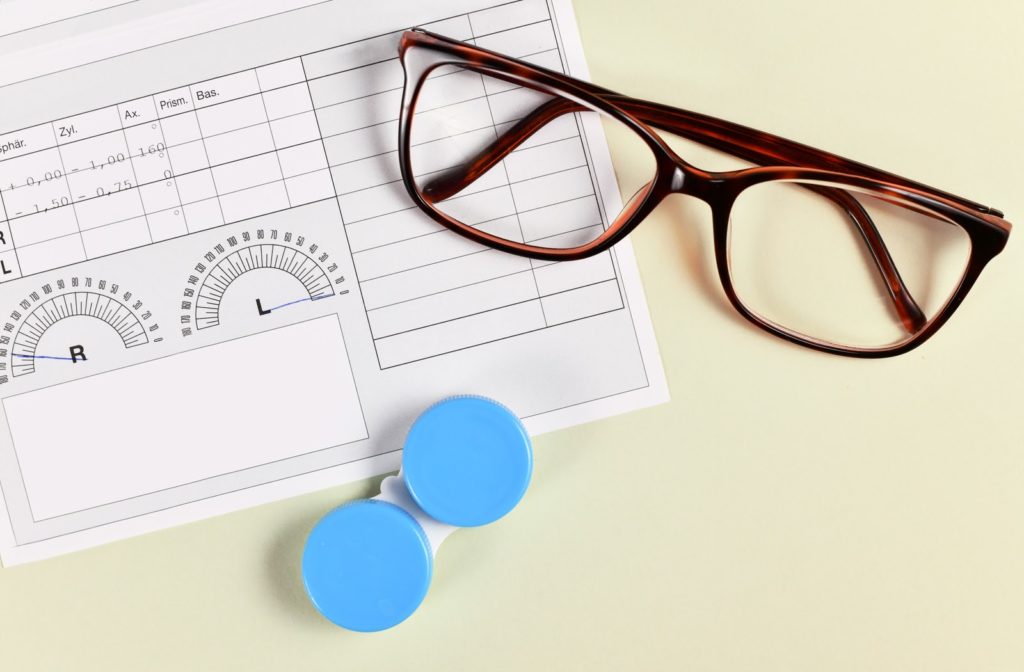If your vision needs correction, your optometrist can write you a contact lens or glasses prescription. Both will help you see better, but what is the difference between these prescriptions?
Continue reading to learn more about glasses and contact lenses, including the differences between these 2 prescriptions.
Glasses
Almost everyone knows what glasses are. They’re a staple of vision correction, with millions using them daily.
Glasses can serve many different purposes based on your needs, coming in 2 main types, single-vision or multifocal lenses. If you struggle to see clearly from multiple distances, multifocal lenses are ideal. You can get bifocal, trifocal, or progressive lenses, depending on your preference.
The Benefits of Glasses
Glasses are easy to use; you only need to put them on, and you’re ready to go. They don’t require any cleaning solutions, and overall maintenance is low. If you want a break from your lenses, all you need to do is take them off.
Besides easy accessibility, glasses are customizable. You can get a personalized pair of glasses that suit your style and visual needs.
Contact Lenses
Contacts are the alternative to glasses. These thin discs sit directly on your eye, providing you with clearer vision. There are several types of contacts available today, including:
- Daily wear lenses
- Daily disposables
- Extended-wear lenses
The Benefits of Contact Lenses
Contact lenses can provide more natural vision. They can’t block your view like glasses frames, and the lenses move with your eye. Another benefit is that contacts don’t fog up or get wet when the weather worsens.
Contacts come in many materials and designs for whatever your needs are. There are several specialty and standard contact lenses available today, including:
- Soft contact lenses
- Rigid gas permeable lenses
- Scleral lenses
- Aspheric lenses
- Toric lenses
- Multifocal lenses
While contacts and glasses both improve your vision, there are a few differences in how these prescriptions work.
What’s the Difference Between a Contact Lens Prescription & Glasses Prescription?
Glasses and contact lenses both correct your vision, but their prescriptions work differently. Your prescription is more than the corrective power of your lenses; it takes several other factors into account.
Glasses Prescription
You’ll notice different numbers and abbreviations listed on your glasses prescription. There is OS (oculus sinister) and OD (Oculus dextrus), which represent your left and right eyes. Each abbreviation has numbers listed underneath them.
These numbers represent the amount of vision correction each eye requires. Generally, the further away from zero, the worse your eyesight is. These numbers are in diopters, the unit measuring the focusing power of your lens.
Another feature on your prescription is a plus (+) or minus (-) sign in front of these numbers, with plus meaning you’re farsighted and a minus meaning you’re nearsighted.
If you have astigmatism, your prescription will feature 3 numbers in the order of “S, C, Axis.” These abbreviations mean:
- Spherical (S): The spherical portion of the lens; the degree of nearsightedness or farsightedness
- Cylinder (C): The degree of astigmatism you have, measured in diopters
- Axis: The orientation of your astigmatism, a number measured in degrees
Contact Lens Prescription
Your contact lens prescription has several specifications to help your optometrist effectively fit your eyes and provide you with clearer vision. Variables in your contact lens prescription include:
- Base curve (BC): The curvature of the back surface of the contact lens, helping to ensure your lens isn’t too loose or tight
- Diameter (DIA): Lens diameter is the specific size of lens you require; it works with your base curve to determine your lens’s fit
- Lens brand or material: Prescriptions require lens brand or material because each lens material has a different level of oxygen permeability
- Expiration date: Your contact lens prescription is typically valid for a year; you’ll need a new examination to buy contacts after your prescription expires
What’s the Difference?
There are a few differences between a contact lens and a glasses prescription. Your glasses are usually 12 millimetres away, while contact lenses sit directly on your eye’s surface. This difference seems insignificant, but it affects the corrective power of your prescription.
Another difference between glasses and contacts prescriptions is the extra specifications needed for contact lenses. Contacts need to fit your eyes comfortably to work effectively, so your optometrist will measure the curvature and width of your eye.
These measurements take place during a contact lens exam and fitting.
What Should You Expect During a Contact Lens Exam?
Your contact lens exam is similar to a standard eye exam, but your optometrist will focus on assessing the best contact lenses for your needs.
This exam includes a discussion about your overall lifestyle and an eye assessment. Your eye doctor will assess the curvature of your cornea to ensure your new lenses fit comfortably. Your pupil size helps determine your lens size.
If you’re looking for a glasses or contact lens prescription, your optometrist can help you. They can assess your overall eye health and vision and determine the most effective options.

Get the Right Prescription
Contact lenses and glasses can help you achieve clear, comfortable vision, and your eye doctor can help you get there. Contact your optometrist if you need new glasses or a contact lens prescription.


